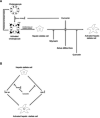The Potentiality of Herbal Remedies in Primary Sclerosing Cholangitis: From In Vitro to Clinical Studies
- PMID: 32587513
- PMCID: PMC7298067
- DOI: 10.3389/fphar.2020.00813
The Potentiality of Herbal Remedies in Primary Sclerosing Cholangitis: From In Vitro to Clinical Studies
Abstract
Primary sclerosing cholangitis is a complex pathological condition, characterized by chronic inflammation and fibrosis of the biliary epithelium. Without proper clinical management, progressive bile ducts and liver damage lead to cirrhosis and, ultimately, to liver failure. The known limited role of current drugs for treating this cholangiopathy has driven researchers to assess alternative therapeutic options. Some herbal remedies and their phytochemicals have shown anti-fibrotic properties in different experimental models of hepatic diseases and, occasionally, in clinical trials in primary sclerosing cholangitis patients; however their mechanism of action is not completely understood. This review briefly examines relevant studies focusing on the potential anti-fibrotic properties of Silybum marianum, Curcuma longa, Salvia miltiorrhiza, and quercetin. Each natural product is individually reviewed and the possible mechanisms of action discussed.
Keywords: bioflavonoids; cholangiocytes; hepatic stellate cells; herbal; phytochemicals; primary sclerosing cholangitis.
Copyright © 2020 Ceccherini, Cecchettini, Morales and Rocchiccioli.
Figures

Similar articles
-
Secondary sclerosing cholangitis.Nat Rev Gastroenterol Hepatol. 2009 May;6(5):287-95. doi: 10.1038/nrgastro.2009.46. Nat Rev Gastroenterol Hepatol. 2009. PMID: 19404269 Review.
-
Prolonged darkness reduces liver fibrosis in a mouse model of primary sclerosing cholangitis by miR-200b down-regulation.FASEB J. 2017 Oct;31(10):4305-4324. doi: 10.1096/fj.201700097R. Epub 2017 Jun 20. FASEB J. 2017. PMID: 28634212 Free PMC article.
-
Biliary tract instillation of a SMAC mimetic induces TRAIL-dependent acute sclerosing cholangitis-like injury in mice.Cell Death Dis. 2017 Jan 5;8(1):e2535. doi: 10.1038/cddis.2016.459. Cell Death Dis. 2017. PMID: 28055006 Free PMC article.
-
Induced expression of heat-shock protein on biliary epithelium in patients with primary sclerosing cholangitis and primary biliary cirrhosis.Hepatology. 1993 Aug;18(2):298-303. doi: 10.1002/hep.1840180212. Hepatology. 1993. PMID: 8340058
-
Fibrotic Events in the Progression of Cholestatic Liver Disease.Cells. 2021 May 5;10(5):1107. doi: 10.3390/cells10051107. Cells. 2021. PMID: 34062960 Free PMC article. Review.
Cited by
-
Novel in vitro evidence on the beneficial effect of quercetin treatment in vascular calcification.Front Pharmacol. 2024 Jan 26;15:1330374. doi: 10.3389/fphar.2024.1330374. eCollection 2024. Front Pharmacol. 2024. PMID: 38344172 Free PMC article.
-
Cytoskeleton Remodeling-Related Proteins Represent a Specific Salivary Signature in PSC Patients.Molecules. 2024 Dec 7;29(23):5783. doi: 10.3390/molecules29235783. Molecules. 2024. PMID: 39683940 Free PMC article.
References
Publication types
LinkOut - more resources
Full Text Sources

